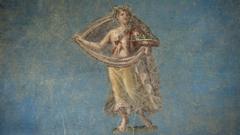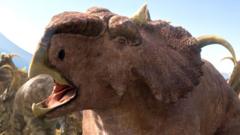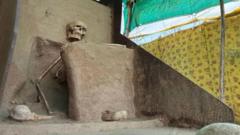The discovery of a private bathhouse in Pompeii, buried for nearly 2,000 years, not only highlights the affluent lifestyles of its inhabitants but also uncovers chilling details of their demise during the AD79 eruption of Mount Vesuvius.
Archaeologists Unearth Lavish Bathhouse in Pompeii, Providing Insight into Roman Luxury

Archaeologists Unearth Lavish Bathhouse in Pompeii, Providing Insight into Roman Luxury
A significant excavation in Pompeii reveals an opulent bathhouse, shedding light on ancient Roman life and the tragedy that struck during the eruption of Mount Vesuvius.
Archaeologists have made an extraordinary find in the ancient Roman city of Pompeii, Italy, excavating what is believed to be the largest private bathhouse uncovered to date. Hidden beneath layers of volcanic rock and ash for nearly two millennia, this opulent facility features a suite of hot, warm, and cold rooms, remarkable artwork, and a vast plunge pool.
Dr. Gabriel Zuchtriegel, director of the Archaeological Park of Pompeii, described the bathhouse as a remarkable glimpse into the past, stating, "It's almost as if the people had only left a minute ago." Alongside this revelation comes grim evidence of the tragedy during the catastrophic eruption of Mount Vesuvius in AD79. Two skeletons, one of a woman clutching valuable jewelry and coins, and another of a young man, were found trying to escape in a small room, only to be overwhelmed by a surge of lethal volcanic gases and ash.
Dr. Ludovica Alesse, a conservator at Pompeii, remarked, "This is a dramatic place, and everything you find here tells you about the drama." While a third of the ancient city remains buried in volcanic debris, fresh excavations provide essential insights into the daily lives of its residents during a pivotal era of Roman civilization.
The bathhouse itself is situated within a grand residence, which has been the subject of a major excavation over the last two years. As archaeologists meticulously unearth the site, they remain joined by a documentary team from the BBC, producing a series titled "Pompeii: The New Dig."
This comprehensive excavation has unveiled an entire block of Pompeii, exposing a laundry, bakery, and the elaborate private home, likely owned by a wealthy individual. Experts suggest that these structures may have belonged to Aulus Rustius Verus, a notable Pompeii politician. The sheer scale of the bathhouse signals the elite status of its owner, with Dr. Zuchtriegel noting the rarity of such complexes in Pompeian homes.
The bathers would have entered a changing area adorned with vibrant red walls and intricately patterned mosaic floors before progressing to the lavish hot and warm rooms. In the grand frigidarium, or cold room, decorated with stunning frescoes, bathers could cool off in a plunge pool large enough to accommodate 20-30 individuals, creating an inviting atmosphere for socializing and relaxation.
Additionally, the excavation has disclosed exquisite elements of the house, such as a banqueting room painted jet black and adorned with classical artworks, and an intimate prayer space with pale blue walls. Tools and materials suggest the residence was undergoing renovations when the disaster struck.
In a poignant contrast, archaeologists also discovered the remains of two Pompeiians who were unable to flee the eruption. One skeleton was found curled on a bed, while the other lay in a cramped corner, crushed under the weight of a collapsed wall. Analysis reveals a stark disparity between social classes, with the elderly woman likely of higher status and the young man showing signs of wear that suggest a life of servitude.
Among the treasures retrieved from the site are gold and silver coins, delicate jewelry, and glassware, now preserved in Pompeii's vault. The finds, described by Dr. Alessandro Russo, illuminate the vibrant lives of those who perished in the volcanic eruption, bridging the gap between ancient and modern history.
Dr. Sophie Hay, an archaeologist, noted the compelling contrast found in these excavations: "The most powerful thing is that stark contrast between the lives of the slaves and the very, very rich." She emphasizes how the remnants of a luxurious lifestyle intertwined with the harsh realities faced by those laboring in servitude are evident in this starkly divided environment.
As the excavation reaches its final stages, archaeologists continue to unearth new artifacts, and limited access is granted to visitors wishing to witness the historical site. Dr. Anna Onesti, director of the excavation, captures the excitement of the ongoing work, stating, "Every day here is a surprise." The newfound bathhouse not only enriches our understanding of Roman luxury but also reaffirms the complexities of life in Pompeii before its devastating obliteration.





















